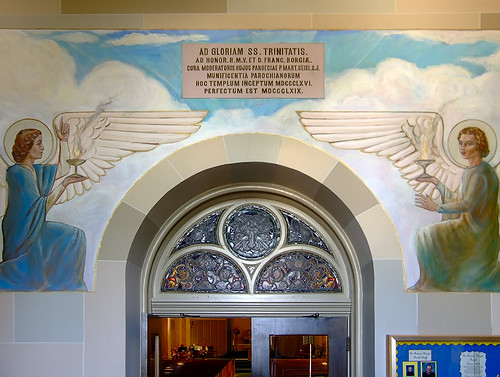
Painting in the narthex of Saint Francis Borgia Church, in Washington, Missouri.
AD GLORIAM SS. TRINITATIS.
AD HONOR. B.M.V. ET D. FRANC. BORGIÆ
CURA MODERATORIS HUJUS PAROECIAE P.MART.SEISL.S.J.
MUNIFICENTIA PAROCHIANORUM
HOC TEMPLUM INCEPTUM MDCCCLXVI.
PERFECTUM EST MDCCCLXIX.
A rough translation (corrections welcome):
To the glory of the Holy Trinity.
To the honor of the Blessed Virgin Mary and Don Francis of Borgia
guardians of this parish's pastor, Martin Seisl, Society of Jesus.
With priests' generosity
this church was started 1866.
Completed 1869.
Correction:
To the glory of the Most Holy Trinity, in honor of the Blessed Virgin Mary and of St. Francis Borgia, under the care of this parish's pastor, Father Martin Seisl S.J., thanks to the generosity of the parishioners, this church was started on 1866 and completed on 1869.


Beautiful.
ReplyDeleteBut those angels were not painted in the 19th century, and the aluminum trim around the doors was not made in the 19th century (besides, in 1869 it would have cost a king's ransom).
The church just had a major renovation in the past year.
ReplyDeleteI remain perplexed, since I can't imagine those angels being done in the 21st century. The style is art-deco-ish... late 30's, perhaps. If those were painted in the last year, the artist has an interesting ability what is a seriously retro style.
ReplyDeleteMy knowledge of art history is approximately zero! Certainly the church has been modified many times since 1869. Many of the churches I've visited have had serious renovations approximately every 40-50 years.
ReplyDeleteD. might be an abbreviation for Divis (or Divi? I don't know) Francis Borgiae rather than Don. Sometimes you see it rather than "sanctus" in dedicatory inscriptions; while it literally means "divine" or "divinized" it is used here in a poetic sense to mean "sanctified." (It was also a conventional way of referring to deceased Roman emperors, even in Christian times, like our term "the late lamented.")
ReplyDeleteI guessed that D. stands for Domus, for the Saint is often called Don Francis.
ReplyDeleteTo the glory of the Most Holy Trinity, in honor of the Blessed Virgin Mary and of St. Francis Borgia, under the care of this parish's pastor, Father Martin Seisl S.J., thanks to the generosity of the parishioners, this church was started on 1866 and completed on 1869.
ReplyDeleteTo the glory of the Most Holy Trinity, in honor of the Blessed Virgin Mary and of St. Francis Borgia, under the care of this parish's pastor, Father Martin Seisl S.J., thanks to the generosity of the parishioners, this church was started on 1866 and completed on 1869.
ReplyDeletesorry for the doble message, I am unfamiliar with this
ReplyDeleteThe angels at St. Francis Borgia were probably painted in the 20s or 30s. As noted, the church is very well cared for, and has had many renovations over the years. The most recent renovators probably painted around undamaged areas, leaving "original" work intact. Too bad about the metal doors, though.
ReplyDeleteFor a wonderfully luscious, not overly "remuddled" early 19th c. church in St. Louis, see St. Mary of Victories. SFB probably looked like that at one time.
No slurs on aluminum, please! My house is aluminum.
ReplyDeleteAs for using aluminum in a church, look at this baptismal font cover in Toledo's Rosary Cathedral: http://bp1.blogger.com/_gbByMNFBss4/SEPVx0l5SlI/AAAAAAAAR5c/8QAvM120DkQ/s1600/28g%2B059_r1.jpg
I don't think that the door is aluminum, or metal at all. I'm sure it is wood, as is the window frame above. It is apparently shiny because I had to open the front door of the church in order to get a good angle for the camera, and so there is plenty of flat lighting causing the reflections.
ReplyDelete